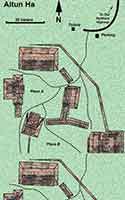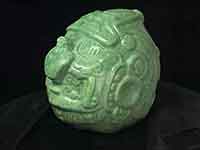Land of the Maya
Altun Ha


The literal translation for Altun Ha is "Rockstone Pond". It was first settled somewhere around 250 BC, with construction of the buildings beginning in 100 AD and continuing throughout the Classic period that ended in the 10th century.
You enter the site from the north-north-east between the large temple A6 and the low A7 into the older of the two plazas. Ahead of you, facing east, is Structure A1 known as the Temple of the Green Tomb. It was the first structure built in Plaza A, and it was expanded 6 times in it's over 400 years of use. A rich burial chamber containing over 300 objects including jade pendants, beads & earrings; obsidian rings, figures and pearls were found within it along with the remains of a Maya codex.

Plaza B has the most famous structure of the site, temple B4, known both as The Temple of the Masonry Altars and the Sun God Temple. A single stairway climbs the temple to an altar perched at the peak. The Temple of the Masonry Altars is Altun Ha's largest temple and is thought to have been the focal point of the community's religious activities. Inside, several tombs were discovered that are believed to have kept the bodies of Altun Ha's high priests. One of these tombs contained an intact crypt. On the right wrist of the entombed skeleton was a jade head representing the sun god Kinich Ahau. 6 inches tall and weighing in at 9.74 pounds, it is the largest jade object ever found in the Maya world. The body was originally covered by Jaguar and Cougar skins and the entire tomb was covered in red pigment.
Altun Ha was an important trading and religious ceremonial center. Construction of the temples at Altun Ha continued until about 1,000 AD.
